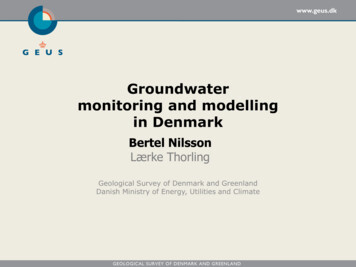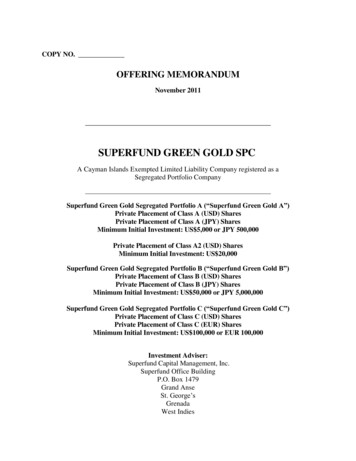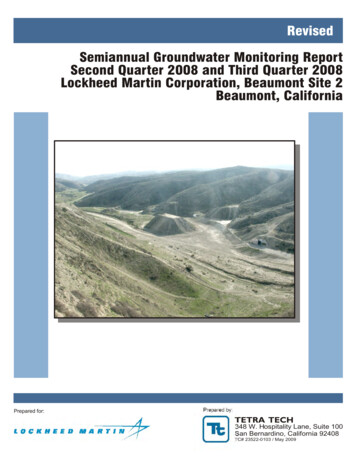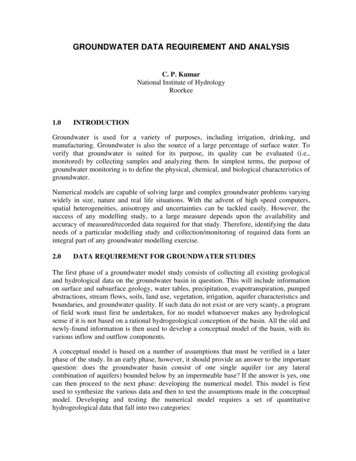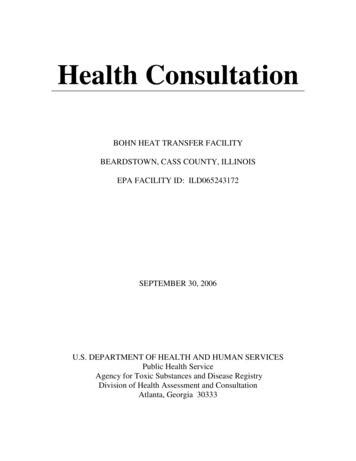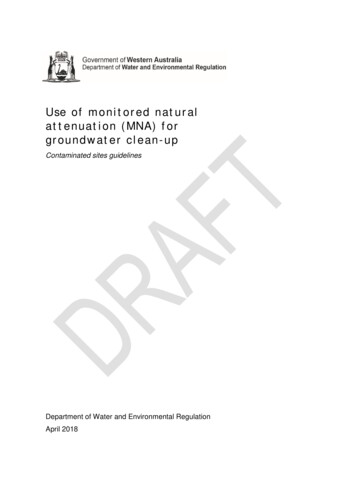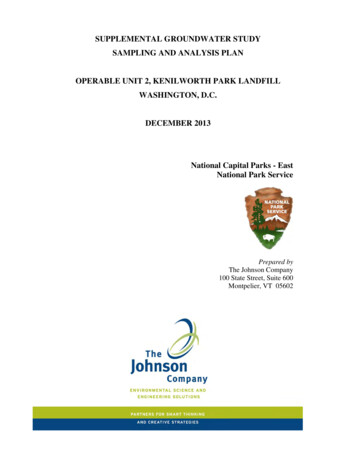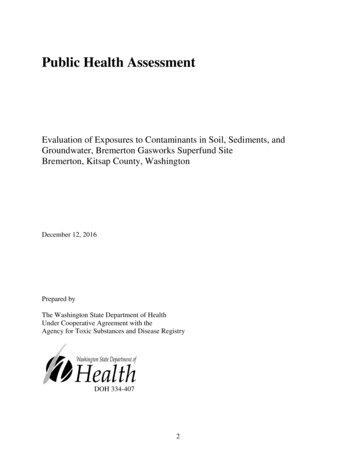
Transcription
Public Health AssessmentEvaluation of Exposures to Contaminants in Soil, Sediments, andGroundwater, Bremerton Gasworks Superfund SiteBremerton, Kitsap County, WashingtonDecember 12, 2016Prepared byThe Washington State Department of HealthUnder Cooperative Agreement with theAgency for Toxic Substances and Disease RegistryDOH 334-4072
THE ATSDR PUBLIC HEALTH ASSESSMENT: A NOTE OF EXPLANATIONThis Public Health Assessment was prepared by ATSDR’s Cooperative Agreement Partner pursuant to the ComprehensiveEnvironmental Response, Compensation, and Liability Act (CERCLA or Superfund) section 104 (i)(6) (42 U.S.C. 9604(i)(6)), and in accordance with our implementing regulations (42 C.F.R. Part 90). In preparing this document, ATSDR’sCooperative Agreement Partner has collected relevant health data, environmental data, and community health concernsfrom the Environmental Protection Agency (EPA), state and local health and environmental agencies, the community, andpotentially responsible parties, where appropriate.In addition, this document has previously been provided to EPA and the affected states in an initial release, as required byCERCLA section 104 (i)(6)(H) for their information and review. The revised document was released for a 30-day publiccomment period. Subsequent to the public comment period, ATSDR’s Cooperative Agreement Partner addressed all publiccomments and revised or appended the document as appropriate. The public health assessment has now been reissued.This concludes the public health assessment process for this site, unless additional information is obtained by ATSDR’sCooperative Agreement Partner which, in the agency’s opinion, indicates a need to revise or append the conclusionspreviously issued.Use of trade names is for identification only and does not constitute endorsement by the U.S. Department of Health andHuman Services. Additional copies of this report are available from:National Technical Information Service, Springfield, Virginia(703) 605-6000You May Contact ATSDR Toll Free at1-800-CDC-INFOorVisit our Home Page at: http://www.atsdr.cdc.gov
Bremerton Gasworks Superfund SiteFinal ReleasePUBLIC HEALTH ASSESSMENTEvaluation of Exposures to Contaminants in Soil, Sediments, and GroundwaterBremerton Gasworks Superfund SiteBremerton, Kitsap County, WashingtonPrepared by:The Washington State Department of HealthUnder Cooperative Agreement with theAgency for Toxic Substances and Disease Registry
ContentsPageForeword2Summary6Purpose and Statement of Issues10Background10Site DescriptionCurrent Conditions and OperationsHistorical Operations101314Environmental Investigations18Natural Resources20Demographics22Discussion22Exposure EvaluationNature and Extent of ContaminationExposure PathwaysData Gaps22222932Health Effects EvaluationScreening AnalysisNon-carcinogenic EffectsCarcinogenic Effects34343535Evaluation of Health Outcome Data37Child Health Considerations37Community Health Concerns38Conclusions41Recommendations41Public Health Action Plan42Appendix A–Glossary45Appendix B–Data Summary493
Appendix C–Exposure and Risk Methodology and Assumptions59Appendix D- Response to Public Comment65References834
List of FiguresPageFigure 1Bremerton Gasworks Superfund area including site-related parcels (A-F),former manufactured gas plant boundary, and state aquatic lands11Figure 2Historical aerial photo of the Bremerton Gasworks Superfund site15Figure 3Former structures of the manufactured gas plant and bulk fueling facilitiesnear the site, Bremerton, Kitsap County, Washington16Contaminated sediments at low tide during October 2010 resulting inemergency action removal of pipe and sediments (photo courtesy ofKitsap Public Health District)19Sample locations from previous investigations25Figure 4Figure 5List of TablesPageTable 1Parcel identification and industrial activities in the area of the BremertonGasworks Superfund site12Chemicals in intertidal sediments exceeding health-based comparisonvalues26Table 3Chemicals in surface soils exceeding health-based comparison values27Table 4Chemicals in groundwater exceeding health-based comparison values28Table 5Exposure pathways30Table 25
SummaryIntroductionPolycyclic aromatic hydrocarbons (PAHs), petroleum hydrocarbons, and metals from theBremerton Gasworks Superfund site in Kitsap County, Washington were released. Thesereleases resulted in contamination of soil, groundwater, and sediment along the shoreline of thePort Washington Narrows. The Bremerton Gasworks Superfund site centers around a formermanufactured gas plant (MGP) that operated from 1930 to 1963. Other past and currentindustrial activities adjacent to the former MGP may have also contributed to contamination.These activities include but are not limited to fuel storage and distribution, marine salvage andrepair, boat part and pier float fabrication, electroplating, sheet metal duct work, concretefabrication, possible landfill activity, etc.This health assessment is mandated by the Comprehensive Environmental Response,Compensation, and Liability Act (CERCLA) of 1980. On September 15, 2011, U.S.Environmental Protection Agency (EPA) proposed to place the Bremerton Gasworks site inBremerton, Washington on the National Priorities List (NPL) in accordance with Section 105 ofCERCLA 42 United States Code (U.S.C.) 9605. The NPL is EPA’s list of the nation’s mostcontaminated hazardous waste sites, also known as Superfund sites. The Agency for ToxicSubstances and Disease Registry’s (ATSDR) goal is to conduct health assessment activities forall sites proposed for inclusion on the NPL. On May 10, 2012, EPA officially listed BremertonGasworks site on the NPL.The EPA is developing plans for a remedial investigation (RI) and feasibility study (FS) forcleanup. Through this process, EPA will determine the site boundary by investigating all sourcesand extent of contamination. For this public health assessment, the term ‘site’ refers to upland,shoreline, and waterway areas near the former MGP. This includes nearby locations of currentand past industrial activities that may have contributed to contamination.OverviewThe Washington State Department of Health (DOH) reviewed the analytical results of soil,groundwater, and sediment samples taken from the site prior to the completion of the 2010 TimeCritical Removal Action. The sediment sampling efforts taken in 2013 are outside the scope ofthis document and are not included in this review. Department of Health will be preparing aseparate document to address the 2010 and 2013 Time Critical Removal Actions. There are fourgeneral areas of public health concern addressed in this document: Potential of exposure from touching or accidentally ingesting chemicals fromcontaminated site soils and shoreline sediments.Potential of drinking contaminated groundwater.Potential of exposure from eating berries grown on the site and eating fish or shellfishliving near the site.Physically unsafe areas near the site.Department of Health reached five conclusions in this public health assessment:6
Conclusion 1. Trespassing on the site could result in physical injury. This is an urgent publichealth hazard. Actions to prevent these hazards have been recommended.Basis for Decision. Several physical hazards are present at the site. The bluff at the end of Pennsylvania Avenue is very steep and has a well-used path. Thispath leads to an area where a rope is necessary to go down to the shoreline. One of theowners, as well as Kitsap Public Health District, has cut this rope to discouragetrespassers.At the bottom of the path, debris from former waste dumping is emerging from the bluffand shoreline sediment. Of concern is a rusted metal tank located adjacent to the path andhidden by brush. A person could very easily fall in or on the tank and become seriouslyinjured.Two large former ballast tanks are abandoned on the shoreline. These tanks are heavy,anchored to the shoreline with an old rope, and do not move. It is not known what was inthese tanks. Access at low tide could result in injury if a person tried to climb these tanks.They may even become trapped if entry is achieved.Next Steps. To protect residents, visitors, and trespassers, Department of Health recommendsthe following: A sign be installed at the end of Pennsylvania Avenue prohibiting beach access.The rusted tank at the foot of the bluff be mitigated to reduce the hazard within threemonths of this assessment being released.The submarine ballast tanks be mitigated to reduce the hazard by the owner incollaboration with EPA and Washington State Department of Natural Resources (DNR)within six months of this assessment being released.Conclusion 2. Touching or accidentally ingesting sediments for more than a year could harmthe health of children or adults.Basis for Decision. PAHs were found in sediments near seeps and a former pipe that led to thebeach. Playing at the beach, touching, or accidentally ingesting these sediments could result in anincreased risk for developing cancer. The risk estimates exceed EPA’s range of acceptableestimated cancer risk.1 For residents who live adjacent to the site, we estimate five additionalcases of cancer will develop for every 1,000 people exposed over a lifetime (78 years). Visitorsand trespassers also exceed the acceptable range of cancer risk. Further information is needed toknow how widespread the contamination is along the shoreline.Next Steps. To protect residents and visitors, Department of Health recommends the following: 1Ongoing source(s) of contaminants be identified and mitigated to reduce the potential ofexposure.EPA’s acceptable increased risk of developing cancer ranges from developing 1 additional cancer case in10,000 people exposed to 1 additional case for every 1,000,000 people exposed (1 10-4 to 1 10-6).7
People protect their health by not walking or playing on the shoreline near the site.Parents monitor their children’s behavior while playing outdoors to prevent them fromgoing onto the shoreline.EPA facilitates the maintenance of the capped area on the shoreline. The cap consists ofan absorbent clay mat covered with large rocks. Maintenance is recommended tocontinue until the extent of contamination is known and a remedy is determined.Kitsap Public Health District facilitates replacement of signs on shoreline warning peopleof contamination.Site access be restricted until further characterization and health assessments arecompleted.Conclusion 3. Department of Health cannot conclude if trespassers are touching contaminatedsoils at the site. The nature and extent of soil contamination are not known. Future changes toland use may lead to increased contact with the soil. More soil sample data will be collectedduring EPA’s upcoming RI.Basis for Decision. Most of the former MGP footprint and industrial locations are now coveredby asphalt. People are not able to contact most of the contaminated soils. However, a smallportion of the former MGP is not covered. Trespassers may come into contact with contaminatedsoils in this area. More sampling and information on future land use is needed to fully assess ifcurrent or future health threats exist.Next Steps. Department of Health recommends the following: Site access be restricted and signed appropriately.Nature and extent of contamination in surface soils be characterized.Future land use be determined based on risks of disturbing remaining contaminants orrecontamination of remediated areas.Conclusion 4. Department of Health cannot conclude if people are being exposed tocontaminants from eating fish or shellfish harvested at the site. Shellfish and fish tissue data areneeded to assess any potential health threat.Basis for Decision. Though uncommon, residents reported stories of people fishing off the bluffalong the site. Commercial shellfish harvest in the area and recreational shellfish harvest onnearby public beaches have been closed for many years. Department of Health closed these areasbecause of combined sewer overflow releases and status as an active harbor. The intertidal areanear the site is not expected to reopen for shellfish harvest. However, the site is situated withinthe Suquamish Tribe’s usual and accustomed (U&A) subsistence fish and shellfish harvest areas.Sediments are contaminated at the site (see conclusion #2) and the extent of contamination is notknown. Fish and shellfish tissue sampling and analysis are needed to determine if a health threatexists.Next Steps. To protect the Suquamish tribal members, Department of Health recommends thatEPA consider developing a fish and shellfish sampling and analysis plan.8
Conclusion 5. No one is drinking the contaminated groundwater located in the vicinity of thesite. No harm is expected.Basis for Decision. The City of Bremerton has never had public drinking water wells in thevicinity of the site. Thus, the people in residences and businesses in the area are not drinkinggroundwater contaminated by releases at the site.Next Steps. No further action is required.For More InformationA copy of this public health assessment will be provided to EPA, Washington State Departmentof Ecology (Ecology), Washington State Department of Natural Resources (DNR), current andpast owners, current tenants, City of Bremerton, the Suquamish Tribe, Kitsap Public HealthDistrict, and the Kitsap Regional Library in downtown Bremerton.A copy of this public health assessment report will be placed on the Department of Health’s website assessment webpage: http://www.doh.wa.gov/consults. If you have any questions about thishealth consultation contact Lenford O’Garro at 360-236-3376 or 1-877-485-7316 at WashingtonState Department of Health.For more information about ATSDR, contact the Center for Disease Control and Prevention(CDC) Information Center at 1-800-CDC-INFO (1-800-232-4636) or visit the agency’s web siteat www.atsdr.cdc.gov.9
Purpose and Statement of IssuesThe purpose of this public health assessment (PHA) is to: 1) determine whether chemicalreleases from the Bremerton Gasworks Superfund site pose a public health threat, 2) recommendappropriate actions to protect public health, and 3) identify data gaps where additional samplingmay be needed to better assess health risks. The Bremerton Gasworks Superfund site centersaround a former manufactured gas plant (MGP) that operated from 1930 to 1963. Other past andcurrent industrial activities adjacent to the former MGP may have also contributed tocontamination.Washington State Department of Health (DOH) prepared this public health assessment under acooperative agreement with the Agency for Toxic Substances and Disease Registry (ATSDR).This health assessment is mandated by the Comprehensive Environmental Response,Compensation, and Liability Act (CERCLA) of 1980. On September 15, 2011, U.S.Environmental Protection Agency (EPA) proposed to place the Bremerton Gasworks site inBremerton, Washington on the National Priorities List (NPL) in accordance with Section 105 ofCERCLA 42 United States Code (U.S.C.) 9605. The NPL is EPA’s list of the nation’s mostcontaminated hazardous waste sites, also known as Superfund sites. ATSDR’s goal is to conducthealth assessment activities for all sites proposed for inclusion on the NPL. On May 10, 2012,EPA officially listed Bremerton Gasworks site on the NPL.The public comment period for this PHA was from February 26, 2014 through March 28, 2014.This final PHA report incorporates changes or revisions and responses to public comments.This PHA is based on the information available about the site prior to the completion of the 2010and 2013 Time Critical Removal Actions. This version of the PHA reflects Department ofHealth’s final conclusions and recommendations for the Bremerton Gasworks Superfund Site atthat time. Department of Health will be preparing a document to address the 2010 and 2013Time Critical Removal Actions. This report will be available on the Department of Healthwebsite and at the Kitsap Regional library in Bremerton, Washington. The final PHA reports willalso be available on the ATSDR website.BackgroundSite DescriptionThe Bremerton Gasworks Superfund site is located in West Bremerton, Kitsap County,Washington. The site is approximately one mile north by northwest of downtown Bremerton andthe ferry dock (Figure 1). It lies along the south shoreline of the Port Washington Narrows lessthan a half mile west of the Warren Avenue Bridge. The site has a gentle north-facing slope withbluffs approximately 40–50 feet above sea level. The Port Washington Narrows connects DyesInlet to Sinclair Inlet. Sinclair Inlet drains into the Puget Sound.10
Figure 1. Bremerton Gasworks Superfund area including site-related Parcels (A–F), former manufactured gas plant boundary, andstate aquatic lands in Bremerton, Kitsap County, Washington.11
The formal boundaries of the site have yet to be determined by EPA. Data collected duringthe remedial investigation (RI) and cleanup feasibility study (FS) will help determine all thesources, nature, and extent of contamination. In addition to the operations at the former MGP,other past and current industrial activities may have contributed to the contamination at the site.For this assessment, the term ‘site’ refers to the upland, shoreline, and waterway areasnear the former MGP footprint (Figure 1).Table 1 provides a list of parcels with known past or current business operations that may havecontributed to contamination.Table 1. Parcel identification and industrial activities in the area of the Bremerton GasworksSuperfund site, Bremerton, Kitsap County, Washington.ParcelParcel NumberCurrent ActivityA3711-000-001-0409Storage (vehiclesand implements)B3741-000-022-0101address not availableaddress not availableC1 3711-000-001-06071723 Pennsylvania AvenueVacantStorage, lightindustrial activity(e.g., welding)CC2 142401-2-025-20081512 and 1550 ThompsonDrive3711-000-010-0002D1805 Thompson DriveBuilding BE3711-000-009-0005F3741-000-001-00071701 Thompson Drive1702 Pennsylvania AvenueStorage, lightindustrial activity(e.g., welding)Marina parkinglot and uplandboat storageVacantBulk fueldistribution(diesel)Past ActivityGas production, former product dock,metal fabrication (cutting fitting,welding, electroplating, sandblasting,and painting)Gas production, bulk fuel distribution,former product dock, industrial and/ormunicipal landfill, metal salvage, andrepair of ship partsGas production, storage, industrialactivities (sheet metal shaping, pipefitting, plumbing storage and supply,pier manufacturing, welding, buildingand repair of boat parts, electricalcontracting, manufacture of granitecountertops, etc.)Fabrication of concrete blocks, sewerpipes, and manholes; concretestorage; concrete covering of pierfloatsMarina parking lot and upland boatstorage; former product pipeline;former product dockBulk fuel distribution; furniturefabrication; marine propellerelectrical repair and parts supplierBulk fuel distribution, former productpipeline and dockNote: Site boundary has not yet been determined by the U.S. Environmental Protection Agency; operation information from site documents(Anchor 2011 (1), Ecology and Environment 2009 (2), Hart Crowser 2007 (3) and current owners; parcel information from Kitsap CountyAssessor (http://kcwppub3.co.kitsap.wa.us/ParcelSearch/ ).Residential areas border these parcels on the east, west, and south. Thompson Drive andPennsylvania Avenue are owned and operated by the City of Bremerton. A combined stormsewer overflow outfall runs from Pennsylvania Avenue and discharges approximately 30 yards12
offshore of the site. The site is located within the Suquamish Tribe’s usual and accustomed(U&A) fishing and shell fishing area. Within the U&A, the tribe has treaty-reserved fishing andshell fishing rights. The tribe co-manages fishery resources with the state of Washington.The intertidal and subtidal lands in this area are state-owned aquatic land managed byWashington State Department of Natural Resources (DNR). This includes the land along theshoreline that is exposed and submerged with the ebb and flow of tides. The shoreline is mostlyaccessible when water is at four feet above mean lower low water 2 ( 4) and below.Current Conditions and OperationsThe following numbered paragraphs describe known current uses on the parcels listed in Table 1and shown in Figure 1. A brief description of parcel conditions that limit or impact humanexposure to site contaminants is also provided. Access to Parcels A, B, and C1 are within a fencewith locked entrance.1. Parcel A: Paved area used for vehicle and implement storage (0.83 acres). The shorelinebanks are steep and have large concrete retaining blocks along the water’s edge. Thebluffs have discarded creosote-treated wood pilings lying against the slopes underneaththe brush. At the edge of the bluff, a strong creosote-like odor can be detected.2. Parcel B: Area is vacant, unpaved, and largely overgrown with brush (0.6 acres). Thesouthern edge of the parcel has two cement foundations that once supported ten aboveground storage tanks (ASTs) (see historical operations below). The two cementfoundations now contain standing water/dried mud. There is a fence along PennsylvaniaAvenue and access is through Parcel C1. Jersey barriers (modular concrete road barriers)separate Parcel B from Parcels A and C1. Along the west side of the parcel, a formerunpaved access road leads toward the shoreline. Unrestricted foot access from theshoreline in this area shows indications of trespasser habitation.3. Parcel C1: Area is paved with seven buildings used for storage and light industrialactivities (2.1 acres). Tenants have access through a locked fenced entrance. Motorizedaccess to Parcels A and B are also through this entrance.4. Parcel C2: Area is paved with four buildings used for storage and light industrialactivities (2.47 acres). Tenants have access through a locked fence.5. Parcel D: Area provides paved marina parking (0.65 acres) and moderately restrictedshoreline access. The Port Washington Marina is located in the Narrows next to thisparcel and runs 81 active boat slips.6. Parcel E: Area is paved with vacant buildings (0.33 acres). The southeast portion of theparcel has cement foundations and exterior pipe connections. These once supported ASTsof the former bulk fueling facility (see historical operations below).7. Parcel F: Area has three buildings and contains a paved bulk diesel fueling facility withsix active ASTs (0.77 acres).2Mean lower low water (MLLW) is the average height of the lower low waters over a 19-year period. Lower lowwater is the lower of the two low waters tides of the day.13
Historical OperationsBremerton Gasworks (Former MGP). The former MGP operations are a source of primaryconcern at the site. The former MGP covered Parcel A, the west of Parcel B, and north ofParcel C1, and portions of the harbor area leased from DNR (Figures 1–3). Under severaldifferent owners, this plant provided manufactured gas to the City of Bremerton customers forlighting, heating, and cooking. The MGP structures were originally constructed to extract gasfrom coal using the carbureted water gas process (3). This process injected steam through anincandescent bed of coke or coal. The water gas produced was then fed into a carburetor where itwas enriched with light hydrocarbons. It is unknown what fuel was used to enrich the water gas.However, petroleum oil-based feed stocks commonly used included naptha; gas oils (diesel,heating, and fuel oils); and residual oils.It was reported in 1942 that wood chips were used to remove the tar from the end product (3;4).The “tar-laden wood chips” and the “soot from the water gas machine” were disposed of at theedge of the plant near the oil storage tanks. These byproducts were used to fill a gully on what ispresumed to be Parcel B. The tar emulsion was dumped in shallow pits dug at random in theground. It is not known when these practices started or ended.Figure 2 demonstrates actual structure configuration and boundaries of the former gasworksplant on a historical photo from the 1950s. Figure 3 provides a more detailed, close-up view ofthe former structures. These structures included a coal storage area; water gas generator; winch;gas holder and gas tanks; diesel, oil, and gasoline tanks; purifiers and scrubbers; tar well; residuecistern; and numerous underground pipes. Figure 2 shows three piers servicing the area.The MGP used a carbureted water gas process from 1930 to 1956. From 1955 to approximately1963, Cascade Natural Gas Corporation produced gas at the facility by blending propane and air(3;5). Over the duration of the plant’s operational period, the former MGP maintainedapproximately 17 petroleum liquid and gas ASTs. Plant operations ceased in the 1960s anddismantling of facility structures commenced by 1971 (3).14
Figure 2. Historical aerial photo of the Bremerton Gasworks Superfund site area in Bremerton,Kitsap County, Washington.15
Figure 3. Former structures of the manufactured gas plant and bulk fueling facilities near the site, Bremerton, Kitsap County,Washington.16
Landfill Activity. Historical photos indicate the shoreline of Parcel B has significantly changedover time. These changes clearly demonstrate that this area has been filled. Most fill activitiesoccurred between 1963 and 1971 (3). No records were available to identify sources of the fillmaterial. The bluff at the end of Pennsylvania Avenue is very steep and has a well-used path.This path leads to an area where a rope is necessary to go down to the shoreline. At the bottom ofthe path, debris from former waste dumping is emerging from the bluff and shoreline sediment.Of concern is a rusted metal tank located adjacent to the path and hidden by brush. A personcould very easily fall in or on the tank and become seriously injured.Bulk Fuel Facilities. Three bulk fuel facilities operated separately from the MGP and storedpetroleum fuels in ASTs. The product arrived by barge and was transferred to ASTs via aboveand below ground pipelines, and then distributed from the ASTs (3;5). Use of the three or fourformer piers was consolidated over time and two or more facilities shared a single pier in lateryears. All former piers have been removed. It is unknown if the underground distributionpipelines still exist or if product still remains in them. The facilities were or are located on: Parcel B. Fuel facility was located adjacent to the former MGP. Ten ASTs were on sitethrough the 1940s. Ownership and specific facility operations are unknown. The tankswere removed by the mid-1990s. In 2003, the current owner attempted to remove anunderground storage tank (UST) without a permit. Washington State Department ofEcology (Ecology) has no record of USTs or removals on this parcel. It is unknown if theUST is still present.Parcel E. Six ASTs, built by Atlantic Richfield Company (ARCO), were operated byseveral different owners/tenants from 1942 to 1992. When ARCO operated the facility,the four ASTs on the western border were labeled as oil tanks (2;3). The plant wasdismantled between the late 1980s to the early 1990s and became a furniture businessuntil 1998, followed by a wholesale marine electronic equipment company. Ecology hasno record of USTs or removals on this parcel.Parcel F. Six ASTs are currently in use by SC Fuels. The footprint of this distributionfacility has changed little since the 1940s. From 1947 to 1968, the ASTs were used forpetroleum products or waste oil (3). The facility now distributes biodiesel. Ecology listsfour USTs as removed from the facility. Prior to removal, one UST contained unleadedgasoline, two contained leaded gasoline, and one contained waste oil.Penn Plaza Storage LLC. This storage facility is located on Parcels A, C1, and C2. Much of theproperty has storage units that contain personal or industrial items. Some industrial activity bytenants has occurred or is occurring on these parcels. Historical operations include: Metal fabrication (cutting, fitting, welding, sandblasting, painting, and manufacturing ofcontainment vessels) (Lee Fabricators).Electroplating operation.Sheet metal operation.Electrical contractor.Building and repairing ship parts.Boat repair.Concrete float (pier) fabrication.17
Concrete fabrication and storage (blocks, sewer pipes, and manholes).State-Owned Aquatic Lands. A complete review of DNR-managed activities along the shorelineof the site is beyond the scope of this document. Several sources may have contributed tocontamination present on the shoreline. These include: Known and unknown effluent drain pipes from the former MGP.Unknown effluent drain pipes from other industrial operations.Contaminated groundwater released from underground seeps.Surface water runoff.Combined sewer overflow releases.Product and/or fuel spills from vessels.Releases from industrial and municipal wastes from Parcel B.Boats (i.e., in the adjacent marina, traveling in the Narrows, abandoned on shoreline).Unknown chemicals in the two abandoned ballast tanks.Creosote-treated pilings from former piers.Environmental InvestigationsThe following environmental investigations have occurred at the site and are listed inchronological order. Data from some of these investigations were used to evaluate the nature andextent of contamination:In 1992, Ecology inspected Lee Fabricators, a former metal fabrication business in operationsince 1986 on Parcel A (3). The business was inspected in response to an initiative fromEcology’s Sinclair and Dyes Inlet Action Program. Ecology identified two contamination issues: One to two inches of uncontained sandblast grit leftover from cleaning metals prior topainting. Grit was high in metal content and entering surface runoff.Storage of accumulated paint sludge containing methyl ethyl ketone used to clean thepaint guns.In 1993, Ecology inspected Pier 44 Cons
Bremerton Gasworks Superfund site in Kitsap County, Washington were released. These releases resulted in contamination of soil, groundwater, and sediment along the shoreline of the Port Washington Narrows. The Bremerton Gasworks Superfund site centers around a former manufactured gas plant (MGP) that operated from 1930 to 1963. Other past and .
